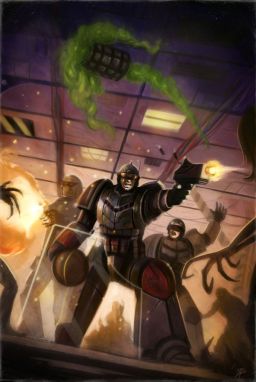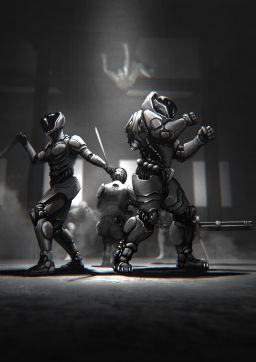Modular: First Time Out With I Love the Corps

A house full of teens playing I Love the Corps!
“Cover the back of your necks! It’s going for your necks!”
“Use the black hole gun!”
“I’m out of Hero Points!”
“Kill them! Kill them!”
“Argh!”
Yes the house is full of teens playing a review copy of indy game I Love the Corps, a self-consciously SciFi game which hits the notes of 90s Military SF, with a dose of Aliens, plus video games like Call of Duty and Mass Effect (the referee’s book has a handy appendix of inspirations, including music). The lads range from 12 through to 16, with my son Kurtzhau, 14, in the middle and in the thick of it refereeing an ambitious one-shot he’s crafted involving rebel humans and sinister uploading aliens, epic scale space dreadnoughts, and more twists than a sack-full of broken micro USB cables.

Same teens, this time as seen from
inside the game. (OMG I love roleplaying!)
The players don’t all know each other! There’s two from the Friday night Traveller group, two mates from music school, plus a complete stranger, the son of Historical Crime Fiction author Caroline Dunford (go read her stuff it’s great) pretty much shipped in to make up the numbers because the biggest challenge of running teen RPG sessions is getting enough players together in the face of random parental decisions (“It’s a nice day cancel your plans we’re going for a walk”/”But Granny’s coming.”/”We need to take you to buy new sneakers”). There’s not even any getting to know-you-time — there’s a four hour slot, and Kurthzau is going to make the most of it. It doesn’t matter. The game picks up momentum like an accelerating grav tank and soon both dice and small arms are rattling.
I’d expected the business of military rank to cause problems. However, the nature of the style of warfare, plus the neat specialisation of the characters, gives all the players a pleasing level of autonomy, while at the same time a sense that having a squad leader is useful. (It helps that the player in question has a good sense of military tactics and manages to prevent everybody getting killed several times.)
We encountered the game and its creator at Conpulsion a couple of years ago. Kurtzhau, 12 at the time, and I each played separately and had a blast (literally). However it utterly hit the spot for the 40K-obsessed, Halo-playing Jack Campbell-reading early teen. There’s been a lot of dice under the bridge since then. We’ve both started refereeing Traveller. Kurtzhau has also become an enthusiastic Starfinder GM. Even so, we watched with anticipation the slow progress of I Love the Corps! from demo game to full production version.
Three things combine to make this game stand out.

First, it’s a Military SF game with the military part baked in
Sure, Traveller creates military characters, and you can do military adventures with it — Kurtzhau did a ultra hi-tech one-shot — but it’s not really optimised for being part of a military organization. The same goes for its narrativist cousin Diaspora. There’s a family of Warhammer 40K roleplaying games, but they have a reputation for being cumbersome and are out of print. We’re waiting for a new 40K game from different developers.
Everything in I Love the Corps! hinges off the military setting, from experience, through equipment upgrades and rules for trauma and horror, to the setting itself, which naturally generates the right scale of adventure through built-in conflict. Even the whimsical stat names — “Drop and Give me Five” is strength — have a military feel. The referee’s guide itself has plenty of useful advice for a novice GM, and for anybody contemplating running military adventures for the first time.
Second, the setting itself is a self consistent Military SciFi one
Chris hasn’t just created a MilSF setting, he’s created a whole technological secondary world. Everything fits together, from the clunky data disks through to the power armour. There’s plenty of description of what different sorts of worlds are like and the places in them. The GM is not left suddenly having to decide how people get around in a high tech city. It’s not an extrapolation — both industry and warfare is still humancentric, and not done by killer microdrones and 3D printing nanobots — and because of that breaks if you look at it too closely, but it’s self consistent and easy to move around at imaginative ground level. The end result feels real and gritty.

The carefully optimised setting — a loose human hegemony seeking to expand, some worlds resisting, others warring among themselves, aliens lurking on the fringes or even within(!) — ensures there’s plenty of fighting going on. (Though it specs some space ships, space travel is handled at story level, and players don’t astrogate.)
I haven’t read the three pre-done scenarios in Mission Dossier, which we also received, because I want to play in them! However, Kurtzhau reports that they all make good use of the setting, and the last one in particular is “absolutely genius” and “really clever”, something he’d never have the time to come up with. They are all richly science fictional, and offer more than just an extended shooting spree, or a railroad through an escalating series of encounters.
Third, it uses narrativist techniques to simulate a genre so you can game it
So we have, for example, Hero Points you can burn off to do stunts, or stay alive — Kurtzhau’s players quickly ran out of these — a structured approach to scenes (“narrative” or “action”) and beats, and the option to have an automatic score for a skill roll. However, these closely model the implicit rules of the gritty MilSF subgenre so that players aren’t so much telling a story collaboratively, as trying to survive it and if possible shape it in the favor of their PCs.
The effect is more immersive than meta, but with just a little ironic detachment to keep things fun. In the two games I’ve played, and in the one Kurtzhau refereed, the players happily fell in with this. According to GNS theory, this isn’t supposed to work, but it does here.
What’s it like to play?
From the prep point of view, it’s not by any means “lite”. There’s loads of background. It’s well thought-out and engaging background that’s fun to have in your head — essentially a study in the genre tropes in its own right — but you do have to take the time to absorb it.

Character generation is points based and detailed, and physically time consuming, since you really do need to copy out the special abilities (“Aspects”) onto the sheet. It’s all a bit like building a Warhammer 40K army, which makes sense given that each PC is a one-man army, but is a bit of an issue for a game that lends itself so well to one shots in which everybody dies. Fortunately, there is a compendium of pre-done archetypes. If these were provided on actual printable character sheets, it would be perfect. NPCs, however, are easy to create and run even en masse, since they mostly have non-rolled static scores.
The system and setting together lend themselves to quite ambitious scenario building. Kurtzhau easily came up with something grand in scope, inspired by his time playing Stellaris. It’s easy to imagine running squad-level scenarios lifted from Old Man’s War or Tanya Huff’s military yarns. It also supports mercenary adventures, so you can pretty much go Hammer’s Slammers.
The actual play runs really smoothly. The character sheets might be laborious to create, but once you have them they’re much like the character cards in boardgames like — say — Elder Sign. Most of the relevant rules are on the sheet, and it’s possible to play at the pace of narrative, which is greatly smoothed by use of the Scene and Beat rules. All this supports increasingly frenetic pacing, with bullets and bolts spraying, and the world exploding. Once you sit around the table, this game does pretty much what it says on the cover.
What do you get?
Physically, you get two meaty books of about 250 and 300 pages each, with plenty of summary tables and printable sheets. (You will want the PDF as well as the hard copy.) There’s inspiring artwork, an index — ARE YOU LISTENING MONGOOSE? — and everything is printed in a retro but readable font. Despite this being a new indy game, the end result is gravitas out of the box, especially important for younger GMs introducing their friends to the world of roleplaying.
Who’s this for?
I don’t think this is for a novice GM unless they have a lot of time on their hands. There’s simply too much of it. It’s also not for somebody like me whose brain is — frankly — already full. However, if you relish setting-heavy games like Starfinder, and you want a gritty military game to really get your teeth into, then this is for you, especially if you like the vibe of the 40K universe with which this seems to share a little DNA. Your players will certainly appreciate it. Take a look at the free quick start adventure and make up your own mind.
M Harold Page is the Scottish author of The Wreck of the Marissa (Book 1 of the Eternal Dome of the Unknowable Series), an old-school space adventure yarn about a retired mercenary-turned-archaeologist dealing with “local difficulties” as he pursues his quest across the galaxy. His other titles include Swords vs Tanks (Charles Stross: “Holy ****!”) and Storyteller Tools: Outline from vision to finished novel without losing the magic. (Ken MacLeod: “…very useful in getting from ideas etc to plot and story.” Hannu Rajaniemi: “…find myself to coming back to [this] book in the early stages.”)
[…] https://www.blackgate.com/2018/02/08/modular-first-time-out-with-i-love-the-corps/ […]